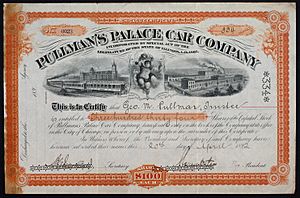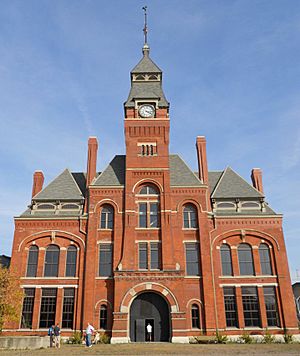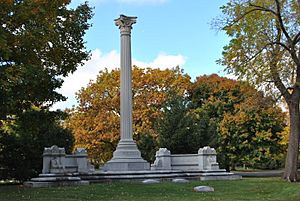George Pullman facts for kids
George Mortimer Pullman (born March 3, 1831 – died October 19, 1897) was an American engineer and businessman. He became famous for designing and building special sleeping cars for trains. These cars were very comfortable, like a hotel room on wheels.
Pullman also created a special town called Pullman for his workers. This town had homes, shops, and other services. However, high rents and low wages in his company town later led to a big worker protest called the Pullman Strike.
His company also hired African-American men to work on the Pullman cars. These workers were known as Pullman porters. They gave excellent service to travelers.
During a tough economic time in 1894, George Pullman cut workers' pay. He also made them work longer hours. But he did not lower the rent or prices in his company town. This caused the famous Pullman Strike. The government sent soldiers to stop the strike, and some people were hurt. Later, a court ordered Pullman's company to sell the town. It then became part of Chicago.
Contents
Early Life and Family Business
George Pullman was born in 1831 in Brocton, New York. His father, James Lewis Pullman, was a carpenter. In 1845, his family moved to Albion, New York. They moved because his father was helping to make the Erie Canal wider.
George's father had invented a special machine. This machine used jack screws to move buildings. He even got a patent for it in 1841. George learned many useful skills by helping his father. He left school when he was 14 years old. His father passed away in 1855. George then took over the family business. In 1856, he won a contract to move 20 buildings in New York.
Building Chicago's Future
In 1857, George Pullman moved to Chicago, Illinois. The city was planning to build its first complete sewer system. Chicago was built on swampy land. The streets were often very muddy.
The city needed to raise its buildings to build sewers and improve foundations. Pullman formed a company called Ely, Smith & Pullman. His company became well-known for lifting large buildings. They even lifted the six-story Tremont House hotel while guests were still inside!
The Pullman Sleeping Car
George Pullman's most famous invention was the railroad sleeping car. He called them "palace cars." These cars were inspired by the comfortable boats he saw on the Erie Canal when he was young. The first one was finished in 1864.
After President Abraham Lincoln was assassinated, Pullman arranged for Lincoln's body to be carried on a sleeper car. This trip gained national attention. Many people saw the special train. Soon, orders for his new cars started coming in. These sleeping cars were very expensive, but they were a big success. They offered "luxury for the middle class."
In 1867, Pullman introduced the President. This was his first "hotel on wheels." It had a kitchen and a dining car. The food was as good as the best restaurants. A year later, he launched the Delmonico. This was the world's first sleeping car focused on fine dining.
The Pullman Porters
Both the President and the Delmonico offered excellent service. Pullman's company hired African-American men as Pullman porters. Many of these men had been domestic slaves in the South. Their jobs included collecting tickets, serving food, and helping travelers.
Being a Pullman porter was a respected job in the black community. It paid relatively well, and porters got to travel the country. George Pullman believed that former house slaves had the right skills to serve the travelers on his "Palace Cars." His company became the largest employer of African Americans after the Civil War.
By 1875, Pullman's company owned many patents. It had 700 cars operating and a lot of money in the bank. In 1887, Pullman also designed "vestibuled trains." These trains had covered walkways between cars instead of open platforms. This made train travel safer and more comfortable.
The Pullman Company Town
In 1880, George Pullman bought a large piece of land near Chicago. He paid $800,000 for it. He hired an architect named Solon Spencer Beman to design his new factory there. Pullman also built a special town next to the factory. This town was for his employees.
The town had homes, shops, churches, theaters, parks, a hotel, and a library. Pullman believed that this clean, well-organized town would make his workers happy and loyal. The town became a popular place for visitors. Many people praised Pullman for his ideas. It was even considered one of the healthiest places to live.
However, Pullman controlled the town very strictly. He did not allow independent newspapers or public meetings. His inspectors would regularly check homes for cleanliness. He could end a worker's lease with only ten days' notice. The church in the town was empty because no church group would pay the rent he asked for. He also did not allow private charities.
The Pullman Strike
In 1894, there was an economic downturn. George Pullman cut jobs and wages for his workers. He also made them work longer hours. But he did not lower the rent or prices in his company town. This made it very hard for workers to live. Some workers earned very little after paying rent.
On May 12, 1894, the workers went on strike. The American Railway Union, led by Eugene V. Debs, supported the Pullman workers. Railroad workers across the country stopped rail traffic. This was known as the "Debs Rebellion."
George Pullman refused to talk with the union. He left town instead. The strike caused problems, including blocking federal mail trains. The government then sent United States troops to stop the strike. Soldiers began shooting at strikers on July 8. By the end of the month, many people had been killed. The strike ended, and Debs was sent to jail.
The strike damaged Pullman's reputation. A government report criticized Pullman for not negotiating. It also said his company town was "un-American." In 1898, the Supreme Court of Illinois ordered the Pullman Company to sell the town. It then became part of Chicago.
Personal Life and Death
George Pullman died on October 19, 1897, in Chicago, Illinois. He was 66 years old. He was buried at Graceland Cemetery in Chicago. George and his wife Hattie had four children: Florence, Harriett, George Jr., and Walter Sanger Pullman.
Burial
Pullman's family was worried that angry workers might try to dig up his body. So, they took special steps for his burial. His coffin was lined with lead and sealed in concrete. A large pit was dug, and its base and walls were made of thick concrete. The coffin was lowered and covered with asphalt and tarpaper. More concrete was poured on top. Then, steel rails were bolted together over that, with another layer of concrete. The whole burial process took two days. His tomb was designed by Solon Spencer Beman, the same architect who designed the Pullman company town.
Legacy and Impact
In his will, George Pullman left $1.2 million to start a school. This school, the Pullman Free School of Manual Training, was for the children of his employees and local residents. Today, the George M. Pullman Educational Foundation helps high school students in Cook County go to college.
The city of Pullman, Washington is named after him. The Pullman Memorial Universalist Church in Albion, New York, was built by Pullman to honor his parents.
The Pullman Company later merged with another company in 1930. It became Pullman-Standard. The company built its last train car in 1982. Its remaining assets were later taken over by Bombardier.
See also
 In Spanish: George Pullman para niños
In Spanish: George Pullman para niños
- Pullman porter
- Pullman, Chicago
- The Brotherhood of Sleeping Car Porters was an important African-American union formed after Pullman's death.






